Motorsports
Earnhardt the Documentary Explains Earnhardt the Man in a Way We Never Thought We’d See
Dozens of sportswriters knew Dale Earnhardt better than I did, or covered him longer. But watching Earnhardt, the four-part documentary now available on Amazon Prime Video, it’s immediately evident that while this program certainly centers around Earnhardt, there are so many ancillary satellites revolving around the main planet, and as part four concludes with an […]
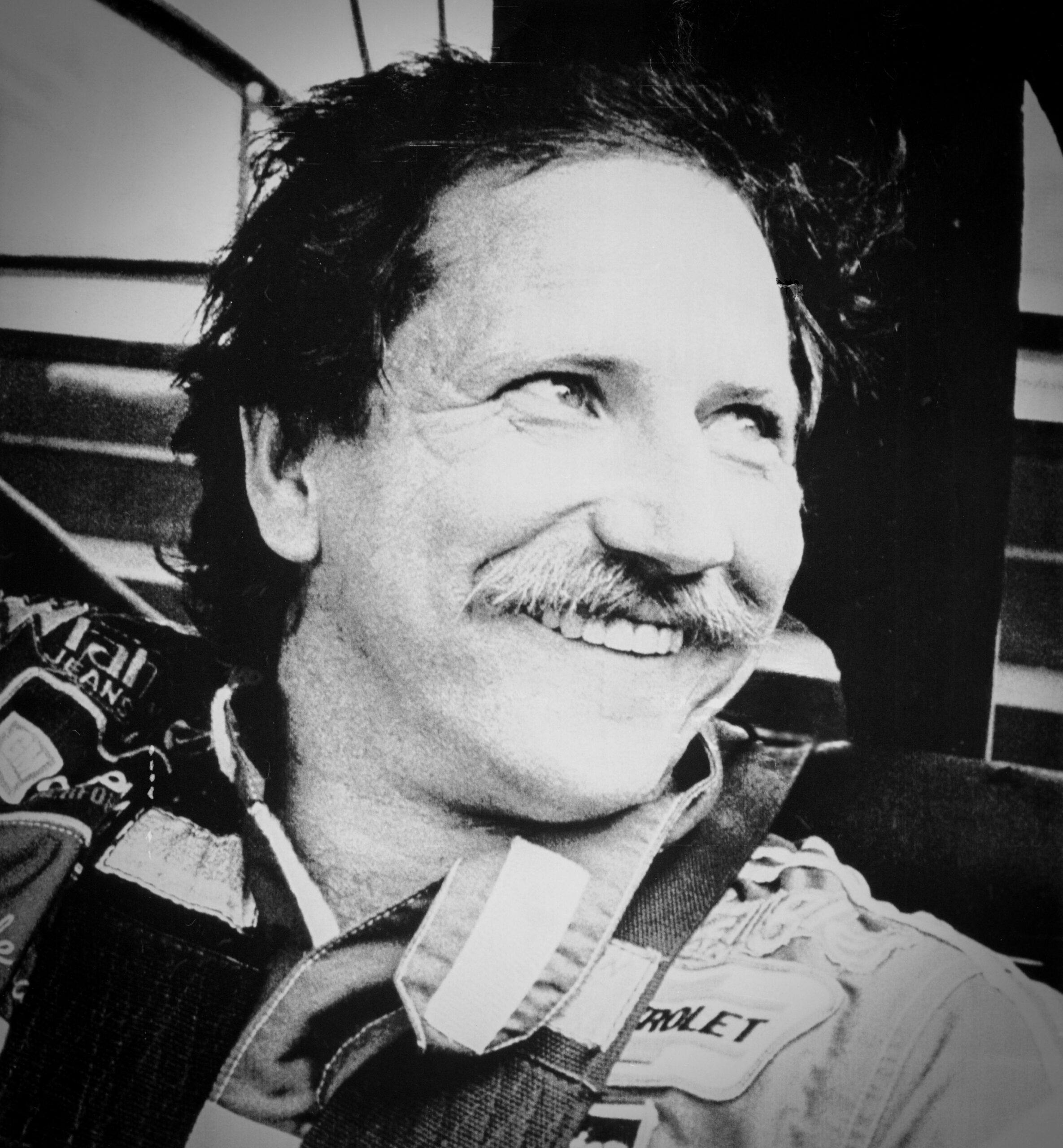
Dozens of sportswriters knew Dale Earnhardt better than I did, or covered him longer. But watching Earnhardt, the four-part documentary now available on Amazon Prime Video, it’s immediately evident that while this program certainly centers around Earnhardt, there are so many ancillary satellites revolving around the main planet, and as part four concludes with an obligatory, sad Willie Nelson song, you click off the remote and think: Man, so much about that time I forgot.
So much about his life, and his death, his friends and his enemies, the way he treated the people he liked, which was different from how he treated his family. How one day Earnhardt started showing up wearing a suit, glamorous third wife Teresa on his arm, became a tycoon, built his Dale Earnhardt, Inc. offices and shop, promptly dubbed the “Garage Mahal,” in 1999. Inside, it was chilly and confusing. Mixed messages abounded. Granite, with gold drinking fountains, plus a stuffed deer that Dale shot, and the shotgun he used to kill it. So many shiny trophies that, lumped together, sort of lose meaning. It reminded me of Graceland.
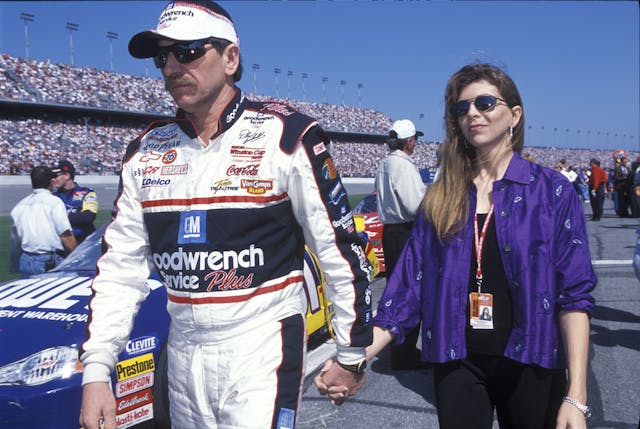
Let’s face it: We all know how this movie ends, in a comparatively innocuous-looking crash on the last lap of the 2001 Daytona 500. So you’re signing up to watch a four-hour documentary because you are either interested in NASCAR in general, Dale Earnhardt in particular, or you just enjoy a well-told story.
The documentary, executive-produced by Ron Howard and his longtime business partner, Brian Grazer, will win awards, and it deserves to: I’ve worked on projects like this, and through all four parts I marveled at the precise footage and perfect soundbites the production team was able to unearth, because I know for every minute of aired footage, they must have had to plow through hours and hours of archives, beg friends and families and fans for home movies, refuse to take no for an answer when they knew what they needed exists, out there somewhere.
You don’t have to be a race fan to appreciate Earnhardt, though it helps, especially if you’ve been around for a while.
I met Dale Earnhardt on November 19, 1989, at what was then the Atlanta International Raceway. It was the Winston Cup season finale—and isn’t that the smartest marketing you ever saw, when you had to actually say the name of a cigarette company when you were referencing the series?—where the ’89 champion would be crowned. I was covering it for the Dallas Times Herald. It was my first NASCAR race. I wasn’t a Times Herald sportswriter; I was actually the paper’s television critic, and I had timed a visit to CNN studios to write a feature on the news network’s upcoming 10th anniversary for an airline magazine (remember those?). It was not a coincidence that there was an important NASCAR race there that weekend—I’d been writing about motorsports for a while, and it came time for me to check that NASCAR box.
So I joined 15 or 20 actual sportswriters in the Atlanta track’s small infield press room, accompanied by nobody I knew, but several I’d heard of. I was not accustomed to being in a room that had no view of the actual racetrack, but soon learned that wasn’t unusual.

It was not a particularly eventful race, until lap 202, when the orange number 22 car of journeyman driver Grant Adcox pancaked the outside wall and burst into flames as the car traveled down the embankment, into the infield. It seemed to take forever to get Adcox out of the car: They had to use the Jaws of Life to cut off the roof. He was taken to the infield care center, then helicoptered to an Atlanta hospital. There’s little question that Adcox was dead before his car stopped rolling, as the mounting for his seat came loose in the impact, and unrestrained, he suffered fatal head and chest trauma, but it is typical of all forms of motorsports to transport the driver to the hospital, where the family can gather and an appropriate member of the clergy breaks the news, and the carefully structured official announcement is made later, so fans can leave unaware that they’d just seen someone die. To a T, that script would be followed 12 years later for Earnhardt himself.
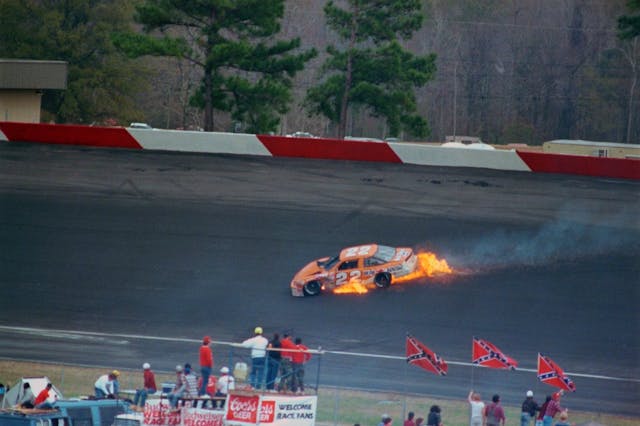
Adcox worked with his father at Herb Adcox Chevrolet in Chattanooga. He never had enough money to compete full-time in NASCAR, but raced regularly in the ARCA series, which used older Cup cars. Dale Earnhardt had said in an interview earlier in the season that he was impressed with Adcox’s talent, and with enough money, maybe he could be a success in the Cup series.
Some of the Cup races Adcox had managed to run seemed cursed. In 1974, Adcox qualified for a race at Talladega Superspeedway. Midway through the event, the caution flag flew, and the drivers dashed for pit road. As he started to pull into his pit stall, Adcox’s car began to slide, right into Gary Bettenhausen’s Roger Penske–owned AMC Matador, which was being serviced by the crew. Several of them were struck and injured, the worst being Don Miller, who lost a leg.
The following year, Adcox again qualified for the race at Talladega, but his crew chief dropped dead from a heart attack right there in the garage. The car was withdrawn, but Adcox found another ride, and then the race was delayed a week by rain. Adcox, a working man, had to cancel, and his spot in the field was given to fan favorite Tiny Lund, the affable 6-foot, 5-inch, 270-pound winner of the 1963 Daytona 500. In a multi-car crash on lap seven, Lund’s car was struck broadside, and he was killed. He was 45. Had Adcox been able to race, Lund would have been watching from the grandstands.
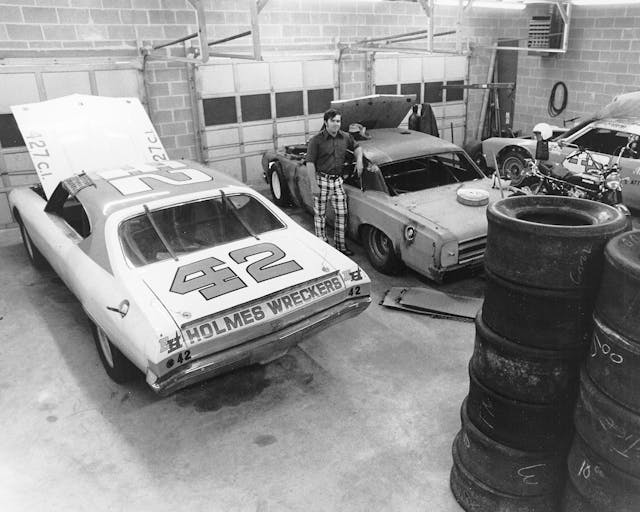
Earnhardt won that race at Atlanta, though he lost the 1989 championship to Rusty Wallace. Earnhardt was cheerful when he came into the press room to talk to us: One of his first comments was, “Boy, I hope Grant’s OK. That was a hard hit he took.” A sportswriter sitting next to me leaned over and whispered, “Did nobody tell him?”
Apparently not, and we sure didn’t. I spoke to Earnhardt briefly, then was soon back in my hotel room, about to type out the story on my wretched Radio Shack TRS 80 laptop. But what was my lede? That Earnhardt won? That Wallace was the champion? That Adcox was the first Cup driver to die in five years? I don’t recall what I typed into the Trash 80, but I typed away. And I had covered my first NASCAR race.
As I went to more and more races, Earnhardt was always a looming presence. He was hated and adored. I fell somewhere in between. Rubbing may be racing, but Earnhardt’s aggressiveness often rubbed me the wrong way, especially earlier in his career. He was polarizing—you either got him or you didn’t.

I apologize for the above autobiography, and I need to get back to Earnhardt. The praise is deserved, and the use of film and clips from TV broadcasts is Emmy-worthy. The TV critic in me was a little put off by the staging of some of the present-day interviews: It isn’t unusual for the interviewer, unseen and unheard in this case, to tell the subject to look at me, not at the camera, but several of the subjects appear to be speaking to someone in another room. The interviews with bass fishing legend Hank Parker, an Earnhardt confidant, are so dark and distant it’s almost like he was being filmed by a hidden camera. But that would be nitpicking director Joshua Altman’s style. Taken as a whole, Earnhardt is top-shelf. Part three drags a bit, but the rest seem right-sized.
As I watched, I took notes. Following are some expansions on those notes, in no particular order, which fans of the man and the documentary might find of interest.
Ralph Earnhardt
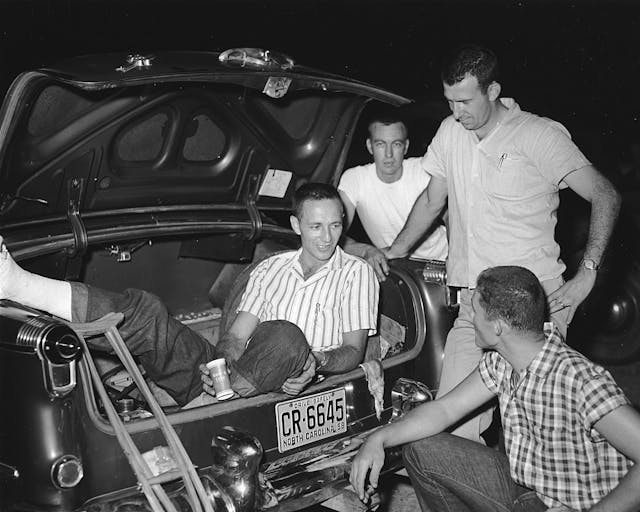
I wanted more from Earnhardt about Ralph Earnhardt than we were served. The importance he played in his son Dale’s life, perhaps not so much by action as inaction, was telling at every turn. Growing up at racetracks in the south, I’d seen dozens of Ralph Earnhardts: Lean, hard-bitten, tanned, wary and suspicious, usually with a pack of Lucky Strikes tucked in their shirt pocket. Ralph was a talented driver, perhaps an even more talented car- and engine-builder, as often as not working for the drivers he competed against on Saturday nights.
Ralph toiled for years in cotton gins, looking for a way out. That would be racing. With his typically German meticulous, practical personality, he wanted more, but didn’t crave it, didn’t demand superstardom, didn’t much want to travel, but he dominated racing for years at local tracks, where he made enough money and got to sleep in his own bed every night. He was sick most of 1973 with heart trouble, had to let his friend Stick Elliott race his car, but was back behind the wheel that summer, and won two races at Concord Speedway. “Veteran Ralph Earnhardt is back in high gear,” said the Charlotte News in July.
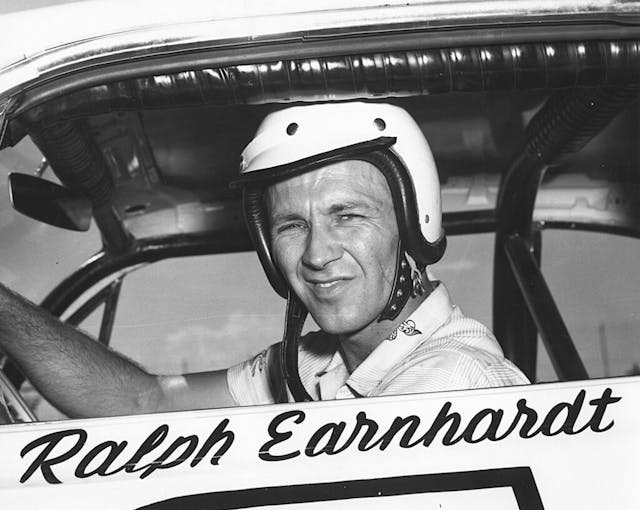
Two months later, Ralph Earnhardt died, at home, from a heart attack. He was 45. Years after, Dale spoke about his father in an interview. “That’s the last funeral I’ve ever gone to. It took me a year or so to get over being mad. I felt like I was robbed. I felt hurt,” Dale said. “It was too tough to take. The memories. All the things I wanted to tell him.”
Which, we learn from Earnhardt, isn’t at all dissimilar from the way Junior felt after losing his father, who was 49.
Teresa Earnhardt

Teresa Houston was pretty, and she knew it. She had grown up around racing—her uncle is Tommy Houston, who had 24 wins and 198 top-10 finishes in the NASCAR Busch series, and her cousin Andy Houston raced in all three of the major NASCAR series. She naturally met Earnhardt at the track, and they married on November 14, 1982.
She wanted to be a mother—her daughter Taylor Nicole was born on December 20, 1988—but she wasn’t crazy about being a stepmother. The relationship between her and Dale’s other kids, son Kerry, daughter Kelley, and Dale Earnhardt, Jr., was icy from the start. Kerry related on Dale Jr.’s podcast that when he was finally invited to his father’s house for the first time—at age 16—Teresa slammed the door in his face.
It may seem that Teresa, now 66, has been unfairly painted as the evil stepmother, but she certainly hasn’t helped her own cause. She virtually disappeared after Earnhardt was killed. She inherited everything: The Garage Mahal, the race teams, so much property, and the spectacularly profitable souvenir business.

Kelley, Kerry, and Dale Jr. got nothing, not even their own names. When Kerry and his wife Rene signed a deal with Schumacher Homes to help design and promote new houses, they called it the “Earnhardt Collection.” The ads were benign, in no way suggesting that Dale Earnhardt or his estate had anything to do with the project. Nonetheless, Teresa filed suit against her stepson in 2017, contending that Kerry, by using the name he was born with, was infringing on her copyright. Kelley and Junior were properly appalled, but not surprised. The case dragged on for years. It’s difficult to even conceive of a reason why Teresa would do this, aside from spite.
It’s worth noting, too, that Teresa had Senior buried on “her” land, and Junior revealed in a very recent Washington Post interview that he has only been able to visit his father’s grave once since he died, because Teresa has forbidden him and Kelley to access her property. Which may or may not be legal, given North Carolina’s confusing laws pertaining to whether or not a property owner can legally bar the next of kin from a gravesite.
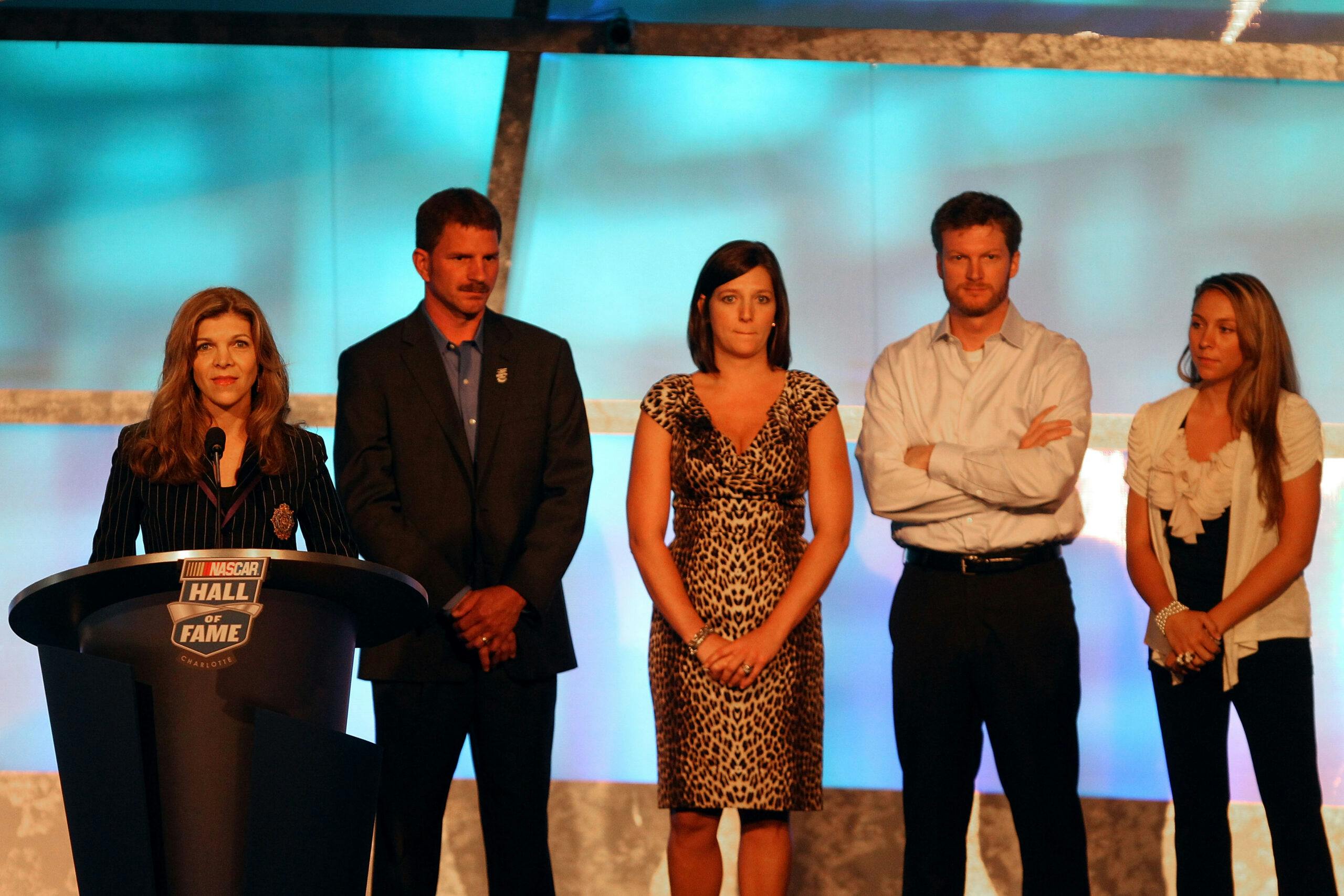
With the possible exception of Brooke Sealey, Jeff Gordon’s first wife, no NASCAR ex has maintained a lower public profile than Teresa. Her name was most recently in the news last October, when she revealed plans for a portion of what the Charlotte Observer called her “vast landholdings.” The paper reported that she had asked the local planning board to rezone 399 acres in Mooresville so she could build an industrial park.
Earnhardt mentioned that Dale Jr. continued to race for the now-Teresa-owned Dale Earnhardt, Inc., until 2007, when the situation just became untenable. After his move to Hendrick Motorsports, sponsors fled DEI, and Teresa had to merge with Chip Ganassi Racing in 2008.
The extent to which Teresa is reviled by so many NASCAR fans wasn’t fully explored in Earnhardt, nor was her toxic relationship with her three stepchildren. It’s just so sad.
Dale Earnhardt, Jr.
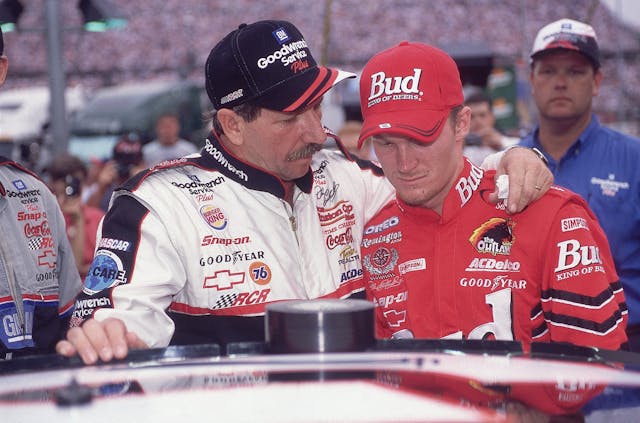
No one is more surprised than I am that I’m describing Junior as a deeply complex man. In his younger years, that would have seemed absurd: What’s so complex about a kid who loves pickup trucks and beer and video games, and hanging out with his buddies, and who very possibly could have found happiness working forever at his father’s Chevrolet dealership?
One thing Earnhardt puts in laser focus was Junior’s need to earn his father’s respect, and he saw racing as being the road to that. Despite being a very wealthy man, Senior repeatedly balked at helping his children race, ostensibly because he wanted them to experience the same maturing desperation that he met and eventually conquered.
Hank Parker says in Earnhardt that he convinced Dale to spend some money helping them out, and Senior did buy them each a late-model car to run at local paved ovals, and a truck and trailer to haul them around in. It’s downright stunning when Junior says that he raced in 159 late-model races, and his father never came to a single one. Junior knew nothing about racecraft, and the man who possibly knew more about it than anyone declined to teach him.

Still, Junior battled through all that to win races—and a burgeoning fan base. When he moved to Hendrick, many of us thought he had it made, but Junior struggled. He had the same equipment Jimmie Johnson and Jeff Gordon did, but they were winning championships and he wasn’t. After a colleague and I interviewed him during the now-defunct NASCAR media tour, we walked away disheartened by how sad Dale seemed. I asked him if he felt he had good chemistry with his current crew chief, and he said, “I’m not sure I’ve ever had good chemistry with a crew chief. I don’t even know what that is.” NASCAR drivers just don’t say things like that to reporters holding tape recorders. Afterward, my friend suggested, not entirely kidding, that Hendrick needed to put him on suicide watch.
When Dale Jr. retired at the end of the 2017 season, he had amassed a very respectable record: 26 wins, two of them the Daytona 500, with 260 top-10s in 631 races.
He and Kelley formed JR Motorsports, which in 2016 began fielding NASCAR Nationwide (now Xfinity) series cars, with the help of Rick Hendrick. The team began winning that first year and hasn’t stopped. Sponsors are delighted to bask in Junior’s company, and he and Kelley seem really happy in their respective roles.
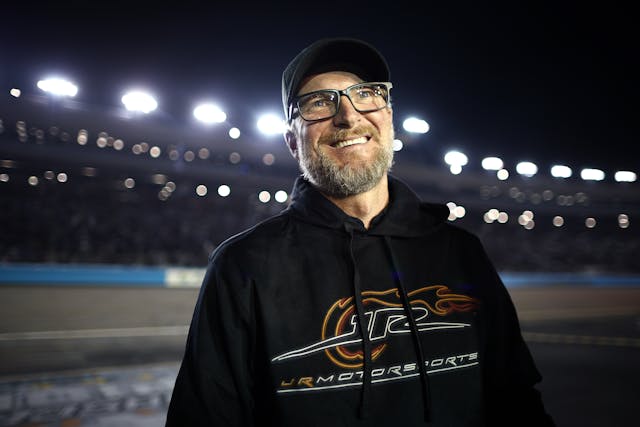
Junior was one of NASCAR’s early adopters when it came to social media, founding the Dale Jr. Download in 2013, with Junior becoming the regular host in 2017. The podcast added video, and as Earnhardt honed his skill as a broadcaster, the Dale Jr. Download has become possibly the single most influential media source there is in the racing world—not just NASCAR, as Junior can and does have guests from all forms of racing. The way Howard Stern can get celebrities to emotionally expose themselves in a way they won’t anywhere else, racers will reveal parts of their lives to Junior that would typically be off limits elsewhere.
Never has Junior seemed so comfortable in his own skin. Years ago, I said this on a radio show that I hosted: If any racer had a license to be an asshole, it’s Dale Earnhardt, Jr. But he isn’t. In person, he’s polite, interested in what you have to say, patient with fans wanting autographs and selfies, and a genuinely nice guy.
I think that comes across in Earnhardt. Because the documentary is supposed to be about Senior, but Junior carries the day. Good for him, and Kelley, and Kerry.

Motorsports
Carson Hocevar admits friends and family raised concerns over NASCAR move – Motorsport – Sports
Carson Hocevar conceded that his move from the NASCAR Craftsman Truck Series to the Cup Series drew considerable backlash from those in his inner circle. Since taking his talents to the top racing series of NASCAR, Hocevar has repeatedly ruffled feathers due to his aggressive driving style. Ryan Blaney described him as a “moron” following […]

Carson Hocevar conceded that his move from the NASCAR Craftsman Truck Series to the Cup Series drew considerable backlash from those in his inner circle.
Since taking his talents to the top racing series of NASCAR, Hocevar has repeatedly ruffled feathers due to his aggressive driving style. Ryan Blaney described him as a “moron” following the Ambetter Health 400, AJ Allmendinger issued him a stern warning at the EchoPark Automotive Grand Prix, Ryan Preece warned “he’ll have his day” after the Wurth 400 and Ricky Stenhouse Jr. threatened to ‘beat his a–‘ on the heels of the Viva Mexico 250.
Most recently, Hocevar drew the ire of Austin Dillon, who called him the ‘biggest dumb—‘ in NASCAR upon getting caught up in a wreck during last weekend’s Grant Park 165.
Though Hocevar’s racing tactics haven’t exactly made him many friends on the grid, they have led to respectable results. Over 19 races, he’s amassed four top-10 finishes, two top-5s and one pole — a far cry from the type of production that Spire Motorsports achieved just several years ago.
Back in October 2023, Hocevar inked a multi-year contract with Spire Motorsports to pilot the No. 77 Chevrolet in the Cup Series. The prior season, the team ranked a meagre 33rd in owner points while in the midst of a strenuous rebuild.
Given Hocevar’s prior success in the Truck Series, several people close to him questioned why he was taking such a massive risk by joining a downtrodden organization. “I had people really, really close to me and my family just be like, ‘Congrats, career suicide. Good job,’” Hocevar said while making an appearance on the ‘Dale Jr. Download’ podcast.
“I had people in my inner circle really close to me that aren’t in that inner circle anymore, but they were just like, ‘Are you f—— sure about this? You’re f—— winning truck races and you’re going to do this?’”
Despite receiving pushback from multiple angles, Hocevar remained committed to chasing his dream of racing in the Cup Series. “I’ve always wanted to drive a Cup car,” he explained. “I didn’t get winning stuff in trucks. If I really believe in myself, I can make this stuff winning, or I can make this stuff better… I’ve done it before. Not just be like, ‘Oh, I’m gonna make this winning,’ but I was like let’s just see where it goes. I just got to get in the door, get to Sunday, and see where it goes. If I was wrong, I was wrong at least on Sunday.”
DON’T MISS:
Now that Spire is a legitimate race contender, Hocevar noted that expectations are higher but the internal intensity has remained the same. “This year, it’s just been like, okay, we have to run up front and get stage points. That’s our goal,” he said. “Last year it was like, okay, we’re looking at points and we’re 18th, but it’s 100 to the next guy. It’s because he’s got 100 stage points — we have nothing.
“Our intensity level I feel like has been the same everywhere. It’s just whether our car or me can handle it on the right day. We’re trying to operate on that level now because if you’re expected to win races, I don’t feel like the moment is gonna be too big because our intensity is here. I feel like guys get that winning opportunity and now they have to raise their intensity up. Now they’re uncomfortable and that’s when they bust their a–.”
Motorsports
Time, TV channel for another road-course race
NASCAR went nearly five decades of modern-era Cup Series racing with just two road courses on the schedule. First it was Riverside and Watkins Glen, then Sonoma replaced Riverside. A third was finally added in 2018 when Charlotte Motor Speedway went road-racing for its second race of each season, and along the way invented the […]
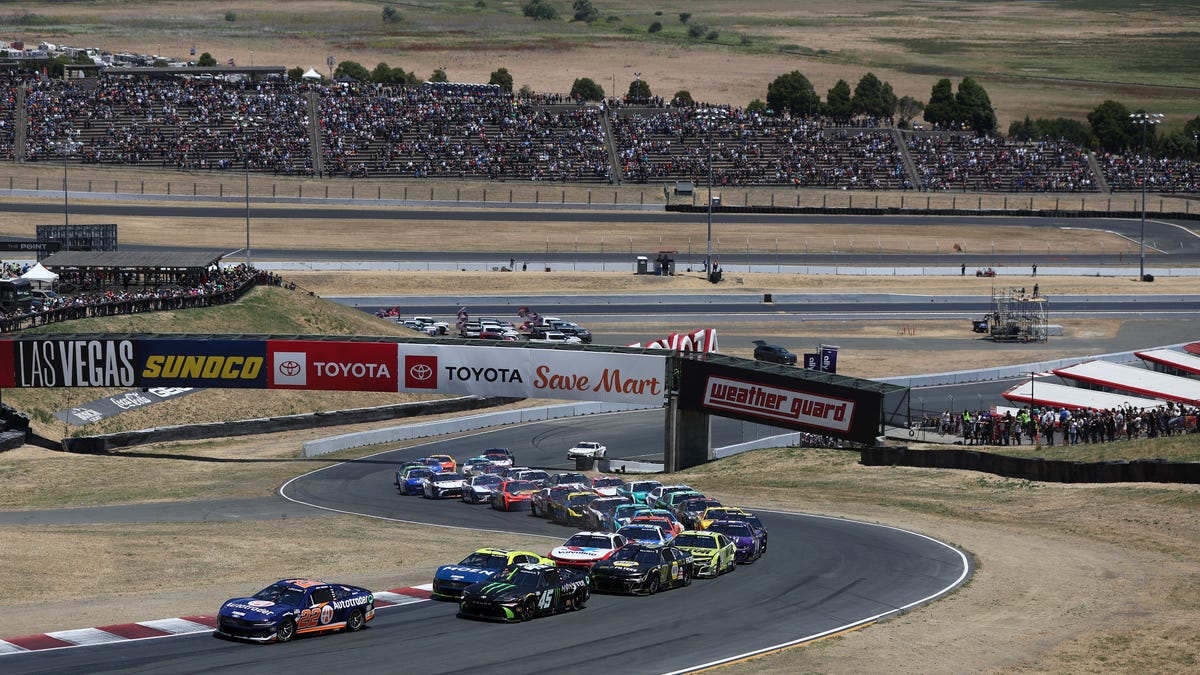
NASCAR went nearly five decades of modern-era Cup Series racing with just two road courses on the schedule. First it was Riverside and Watkins Glen, then Sonoma replaced Riverside.
A third was finally added in 2018 when Charlotte Motor Speedway went road-racing for its second race of each season, and along the way invented the word roval to define its combination of road course and traditional oval, which is actually a quad-oval, but let’s move along.
Watch NASCAR on Sling TV
These days there are five road courses. Not only that, this weekend the Cup Series runs its second road-course race in seven days. A week after the Chicago Street Race, they disturb the peace in California’s wine country, where Sonoma Raceway is host to a Cup race for the 36th time since 1989.
The best current road-course racer in NASCAR, Shane van Gisbergen, attempts the hat trick after winning the past two Cup roadies — in Mexico City last month and Chicago last week.
And if you’re thinking, “I’d like to watch that, I wonder if I can,” you’re in luck. You can watch that, along with other NASCAR racing, and if you thought we were gonna keep the times and channels a secret, you’re sadly mistaken.
Friday: Right-hand turns for Xfinity Series
4 p.m.: Xfinity Series practice (CW app).
5:05 p.m.: Xfinity Series qualifying (CW app).
Saturday: NASCAR Cup Series qualifying, Xfinity race at Sonoma
1:30 p.m.: Cup Series practice (TruTV).
2:40 p.m.: Cup Series qualifying (TruTV).
4:30: Xfinity Series, Pit Boss/FoodMaxx 250 (CW).
Sunday: Can SVG win a third straight road race?
3:30 p.m.: Cup Series, Toyota/Save Mart 350 (TNT).
Motorsports
Carson Hocevar reveals team thought he had ‘medical emergency’ amid Ricky Stenhouse Jr. Mexico City incident
Carson Hocevar got into it with Ricky Stenhouse Jr. during NASCAR’s trip to Mexico City in June. During an appearance on the latest episode of the Dale Jr. Download, the Spire Motorsports wheelman revealed his team was so confused about the incident that they thought he suffered a medical emergency. The Portage, Michigan native accidentally […]

Carson Hocevar got into it with Ricky Stenhouse Jr. during NASCAR’s trip to Mexico City in June. During an appearance on the latest episode of the Dale Jr. Download, the Spire Motorsports wheelman revealed his team was so confused about the incident that they thought he suffered a medical emergency.
The Portage, Michigan native accidentally lost focus and turned the former Daytona 500 winner. According to Hocevar, he went through some serious brain fog at the moment, and didn’t mean to hit Stenhouse Jr. at the time. Still, the Hyak Motorsports wheelman wasn’t hearing any of it.
“Remember when Riley [Herbst], like, hooked around and the No. 47 was really close, and then like he like, putted right? I almost hit him. I thought his car was dead. I thought he hit the No. 35, so he’s putting over. So, he turned left. I was like, ‘Oh f***,’ and I locked up the brakes. We run a bunch of laps, and I’m just trying to get comfortable. The straightaways are so long, our cars are kind of slow with the horsepower, with the elevation and everything, and I noticed he was catching the guys in front,” Hocevar explained.
“I was like, ‘I’m going to earn some back here. I’m going to push him down the straightaway,’ so I was kind of staying close and everything. Just the biggest brain-fade ever. I got in the corner, and I was just like, ‘Oh, there’s a corner here,’ so I went to the break. I locked up. I just got zoned out. I was just like, you know, banging gears. Now there’s like five to go, and I’m just like, ‘Caution’s not going to come out. Yep, yep, yep. This is normal.’ For a minute, my guys thought I like, passed out, because my car just goes straight.
“I am legitimately in there, just holding the wheel straight, either getting ready to turn right to go to the garage. Not actually, but I was just literally sitting there and I’m watching him and I don’t even turn the wheel. I just literally like stop, and I’m just watching him spin. I’m just like, ‘Please for the love of God, save this thing. Even if you lose a spot, just save it,’ and I just watch him spin around.
“I’m just like, ‘Okay, do I just wait for him to go? Do I just get wrecked now?’ So I just stay — my car just stayed there for a while. They thought I legitimately like, a medical emergency, like I passed out from the heat and whatever. But I was just like, no. I was just sitting there watching.”
At the least, it certainly adds an interesting layer to the incident between Hocevar and Stenhouse Jr. in Mexico City. Evidently, Stenhouse Jr. bought Hocevar’s explanation, as there haven’t been any problems between the two drivers since that moment.
Moving forward, Ricky Stenhouse Jr. won’t give Carson Hocevar much grace on the track, but he’s put their scuffle in Mexico behind them, it seems. When these two are racing over the course of the summer, though, don’t expect any love, as they’re going to continue racing each other hard regardless.
Motorsports
Nascar driver Brad Perez talks about racing at Sonoma
Nascar driver Brad Perez talks about racing at Sonoma – CBS San Francisco Watch CBS News Nascar is making its annual stop at the Sonoma Raceweay this weekend, culminating in the Toyota Save Mart 350 on Sunday. Driver Brad Perez, who is competing in Saturday’s race, talks to CBS News Bay Area reporter Veronica Macias […]
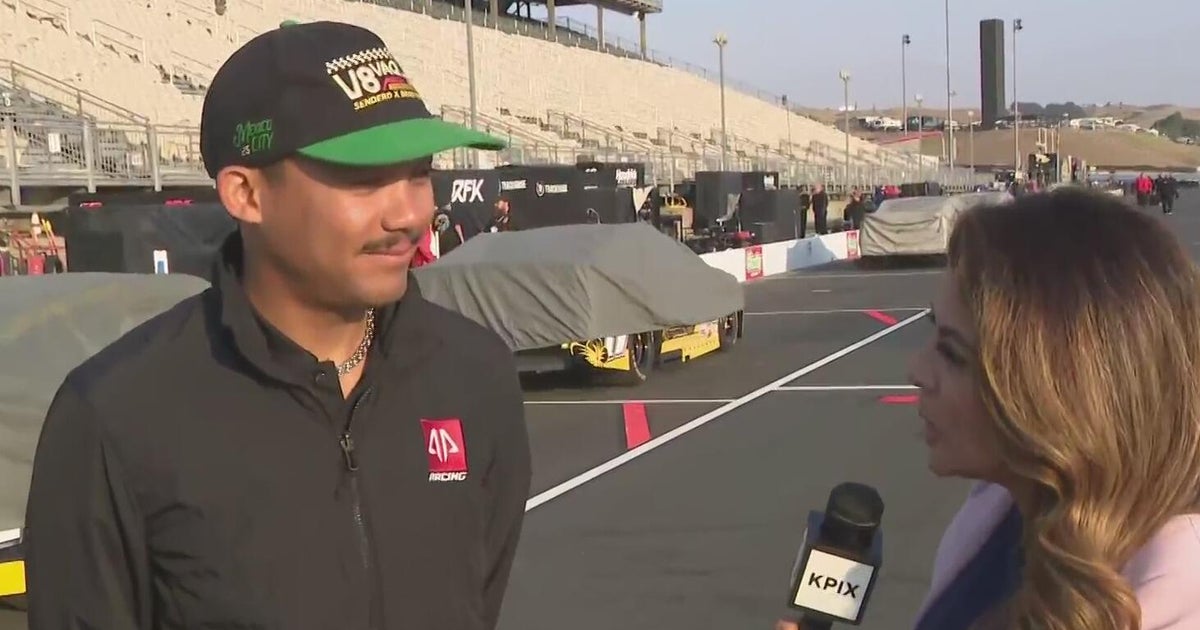
Watch CBS News
Be the first to know
Get browser notifications for breaking news, live events, and exclusive reporting.
Motorsports
Super Subs and Rivals Ready for Revised CTMP Field – Speedway Digest
Tom Blomqvist expects something from himself this weekend. He calls it “standard expectations for a professional racing driver,” but they carry more weight than usual. He’s in a different car, in a different class, with a different team. One that’s leading the championship standings, by the way. But Blomqvist is a key figure ahead of […]

Tom Blomqvist expects something from himself this weekend. He calls it “standard expectations for a professional racing driver,” but they carry more weight than usual.
He’s in a different car, in a different class, with a different team. One that’s leading the championship standings, by the way.
But Blomqvist is a key figure ahead of Sunday’s Chevrolet Grand Prix at Canadian Tire Motorsport Park, as one of several fill-in drivers in Le Mans Prototype 2 (LMP2) for IMSA WeatherTech SportsCar Championship regulars.
Blomqvist will fill in for Paul Di Resta with United Autosports USA as Di Resta is one of a handful of IMSA drivers competing in the FIA World Endurance Championship race in Brazil this weekend.
Blomqvist Entrusted for United Encore
Blomqvist will join Daniel Goldburg in the No. 22 United Autosports USA ORECA LMP2 07. The No. 22 car enters the weekend leading the LMP2 standings by 94 points over Felipe Fraga and Gar Robinson in the No. 74 Riley ORECA.
The one-off duty is both an honor and a unique challenge, Blomqvist explained.
“They’ve entrusted me with this role to do the job,” said Blomqvist, who also drove for United in the 2023 FIA WEC season. “I’m fully aware of that. I expect myself to do well and to perform.
“I’m comfortable with the team, and I’ve worked with them before. I enjoy working with them. I know the car very well, and I’ve had great success at the track before, as well, which is obviously very helpful.”
It’s helpful to be on a roll, as well. Blomqvist and Colin Braun teamed to win the Sahlen’s Six Hours of The Glen on June 22 at Watkins Glen International overall and in Grand Touring Prototype (GTP) in the No. 60 Acura Meyer Shank Racing w/Curb Agajanian Acura ARX-06.
Blomqvist also has a winning relationship with CTMP, the track formerly known as Mosport. In 2023, he and Braun teamed to win in the Meyer Shank Acura on the 10-turn, 2.459-mile circuit. A year earlier, Blomqvist set the outright track record in a previous generation Daytona Prototype international (DPi) car, the Acura ARX-05.
“The track is a lot of fun – a ton of fun,” Blomqvist said. “It’s always one you want to drive, especially in LMP2 cars. It’s the perfect track for the class. I’ve obviously been in the right place at the right time when I’ve been there. I’d like to do the same with Daniel and the guys this year.”
Blomqvist can also speak to those GTP regulars playing in the LMP2 field this weekend.
“The P2 is a little bit of a different driving style – more of a natural driving style because of the lack of electronic aids,” Blomqvist said, comparing the LMP2 car to the GTP.
“They’re a bit lighter, and the engines are obviously completely different. Even the little things like seating position are a little different. But ultimately, it’s a race car, and in my case, I’m used to jumping between the two cars.”
MSR Teammates and Now Fun Rivals … Again
For the second time in two months in two series, one of Blomqvist’s Acura MSR teammates will be a rival in another LMP2 car.
Renger van der Zande, who races the sister No. 93 Acura MSR entry with Nick Yelloly, is another fill-in driver this weekend at CTMP.
Van der Zande will fill in for Sebastien Bourdais in the No. 8 Tower Motorsports ORECA LMP2 07 this weekend with co-driver John Farano. Van der Zande and Bourdais won overall at CTMP in 2022 in a Chip Ganassi Racing-prepared Cadillac DPi-V.R.
Coincidentally, the Dutchman raced for United Autosports in the 24 Hours of Le Mans last month while Blomqvist, Yelloly and Colin Braun were in three other LMP2 cars. On Sunday, van der Zande will race against United and against his Meyer Shank teammate, Blomqvist.
“It’s going to be fun,” van der Zande laughed ahead of Le Mans before the first of his two LMP2 cameos. “I mean, if I suddenly get a free slipstream somewhere, I’m sure it’s (Blomqvist).
“You know we get along very well. … We have a good understanding, have the bigger goal, big picture in mind. It’s gonna be fun to be racing against each other.”
The occasional fill-in role allows drivers to experience the inner workings of other teams. Van der Zande encountered it at Le Mans, where he teamed with Pietro Fittipaldi and David Heinemeier Hansson to finish seventh in LMP2 in the No. 22 United Autosports entry.
“There’s a great organization behind it,” van der Zande said of United. “I was very happily surprised about the atmosphere. It’s a real group of real racers. … I felt home straight away, so it was a great opportunity to get to know another team.”
Now he’ll go up against his teammates from the recent past, against his teammate from the present, in a car they don’t always drive.
Recapping The CTMP Changes
It’s not uncommon for sports car drivers to freelance during the season, especially when scheduling conflicts arise. Beyond Blomqvist and van der Zande, five other LMP2 cars have revised lineups this race.
As Di Resta, Malthe Jakobsen and Mikkel Jensen race Peugeot 9X8 Hypercars at Sao Paulo, Alex Quinn (No. 04 CrowdStrike Racing by APR) and Hunter McElrea (No. 11 TDS Racing) fill in for Jakobsen and Jensen, respectively.
Quinn, who raced alongside George Kurtz and Nicky Catsburg at the 24 Hours of Le Mans, has made five IMSA starts and races alongside Kurtz. McElrea, who won the Michelin Endurance Cup as third driver with Jensen and Steven Thomas last year, is set for his IMSA sprint race debut.
Two new Canadians make their series debuts on home soil. Phil Fayer takes over for Nick Boulle, last year’s CTMP winner and LMP2 champion, in the No. 2 United Autosports USA ORECA alongside Ben Hanley. Travis Hill steps into the No. 18 Era Motorsport ORECA alongside Ryan Dalziel, the major race-winning sports car veteran who is now also Era’s sporting director.
JDC-Miller MotorSports also makes its season debut in the class, with Gerry Kraut and Scott Andrews back in their No. 79 ORECA for the first time since Road America last season, where they finished second.
Fittipaldi races in one of the five unchanged full-season lineups competing this weekend in IMSA, with Chris Cumming in the No. 73 Pratt Miller Motorsports ORECA. Both “DHH” and Tobi Lutke’s commitments allow for Hill’s debut at Era.
The four other cars that are unchanged from Watkins Glen, save for dropping from three drivers to two, are the No. 43 Inter Europol Competition (Tom Dillmann and Jeremy Clarke), No. 52 PR1 Mathiasen Motorsports (Mathias Beche and Rodrigo Sales), No. 74 Riley (Fraga and Robinson) and No. 99 AO Racing (Dane Cameron and PJ Hyett) ORECAs.
The evolved CTMP entry list creates a fascinating scenario as to whether the full-timers or the fill-ins will prevail both overall and in LMP2.
Live coverage of the Chevrolet Grand Prix can be seen Sunday at 2 p.m. ET on USA Network, YouTube and IMSA.tv.
IMSA Wire Service PR
Motorsports
Forza Motorsport’s New Open Division – Gamers Are Not Feeling Positive Amid Studio Turmoil
Latest update for Forza Motorsport was just introduced by Turn 10 Studios and sponsored by Open Division Rivals, wherein competitors create a machine that has the best performance possible under an imposed PI limit for each PI category. Exciting, right? Response? I’d say it’s nothing worth a victory lap. Replies to the announcement tweet flooded […]

Latest update for Forza Motorsport was just introduced by Turn 10 Studios and sponsored by Open Division Rivals, wherein competitors create a machine that has the best performance possible under an imposed PI limit for each PI category. Exciting, right? Response? I’d say it’s nothing worth a victory lap.
Replies to the announcement tweet flooded it: hype followed by frustration, confusion, and doomposting. And honestly, for a good reason: Microsoft laid off a good chunk of the staff of Turn 10 just recently, and gamers are not feeling positive about the future of this franchise.
What Format Is Open Division Rivals?
Open Division Rivals is a bit of a flex zone for car-builders. Take any production vehicle in the game, tweak it to a PI limit assigned to its class, then compete to set the fastest lap time. Being a permanent addition means this is not some limited-time event, so if you’ve got some min-maxing to do, this is your turf.
But this launch time is the worst time possible.
Layoffs & Uncertainty: The Elephant in the Room
Many replies neglected to pay attention to the new mode and just went for the throat: “Why bother when it’s cancelled?” another user asked in a very straight manner. One more commented, “Hard to feel confident in this game at all with how MS has cut back your team quite a bit.”
Ouch.
That skepticism is justified. The recent cuts hit Turn 10 hard, and while the studio hasn’t officially announced any cancellations, the deafening silence has prompted the questioning of the matter. Some even accused the devs of purposely avoiding the question when one frustrated fan shouted, “Answer questions about Forza Motorsport series future!”
Then, there was the whole side track about the “Is this even a real-person posting?” idea. One reply speculated that maybe the Forza account is generally automated now, just tweeting press releases at some timer, all the while the real team is… well, who-knows?
Mounting the Defenses
Not everything was doom and gloom, though. Few players kept up the good fight, calling Forza a “pioneer of simulation” and urged them to “keep it up.” Another wants just “more tracks Originals PLEASE.” And there was that wholesome Mustang fan dreaming of realizing the dream of owning a Ford IRL.
But let’s be honest; the overall atmosphere? Aside from dark gloominess, sprinkled with occasional ‘meh’ from the distracted.
What’s Next for Forza Motorsport?
Turns out that undertaking is stilled somewhere in a waiting game. Despite the arrival of the new mode, biggest would be concerning if Turn 10 could even sustain the game for the long term or for that matter would want to. Shaken in their regard for the confidence, despite no official word on the next thing, players are left dead between hoping for the best or expecting the worst.
In any case, regaining the community will require much more from Turn 10 than just putting out a new Rivals mode.
In the interim? If you’re still into Forza Motorsport, meanwhile, Open Division Rivals is having the time of its life. The big question is: does the game itself have a future?
-

 Technology2 weeks ago
Technology2 weeks agoPet fitness and wellness trends for a healthier and happier dog
-

 College Sports2 weeks ago
College Sports2 weeks agoWAC to Rebrand to UAC, Add Five New Members in 2026
-

 Motorsports2 weeks ago
Motorsports2 weeks agoWhy Cosmetics are Making Up for Lost Time in Women’s Sports
-

 College Sports3 weeks ago
College Sports3 weeks agoAlabama Basketball
-

 Professional Sports3 weeks ago
Professional Sports3 weeks agoFrancis Ngannou sends Dana White a message following Jon Jones' shock UFC retirement
-

 College Sports2 weeks ago
College Sports2 weeks agoA new era of Dickinson hockey begins behind the bench – The Dickinson Press
-

 Sports3 weeks ago
Sports3 weeks agoSEC Conference imposing a fine will create the opposite effect.
-

 Health2 weeks ago
Health2 weeks agoFlorida assault survivor shares hope for change with new mental health law
-

 Motorsports2 weeks ago
Motorsports2 weeks agoNASCAR This Week – Patriot Publishing LLC
-

 Youtube2 weeks ago
Youtube2 weeks agoFunniest MLB rain delay moments































